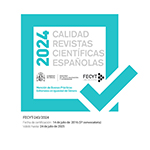An epistemological reformulation of SWOT analysis in Social Work
Abstract
The SWOT is an organizational diagnostic tool from the field of business sciences, applied to the analysis of companies in the market context. The methodological application of SWOT has been extended in various disciplines, including social work, for the situational analysis of groups, collectives, organizations, communities and broader social realities, constituting a tool for social diagnosis recognized socially and scientifically. Its application is taught in the degree of social work in an uncritical manner and without a questioning of its epistemological foundation, which conditions its methodological application. Based on the analysis of Weaknesses, Threats, Strengths, Opportunities, the tool proposes to cross these variables to develop four types of strategies whose enunciation is based on an economic and violent vision, far from the principles of social work and which, moreover, does it is not adapted to the functions performed by our profession. This proposal makes a critical review of the SWOT and proposes its adaptation to the discipline and exercise of Social Work. In this regard, the option is proposed for the literal translation of acronyms SWOT, which emphasizes the analysis of the capabilities and potential of the population and the possibilities of the environment, as well as the redefinition of the type of strategies, adapting them to functions of the profession: information and promotion; prevention, awareness and mediation; integral attention and assistance; and evaluation, coordination and planning.
Downloads
Article download
License
In order to support the global exchange of knowledge, the journal Cuadernos de Trabajo Social is allowing unrestricted access to its content as from its publication in this electronic edition, and as such it is an open-access journal. The originals published in this journal are the property of the Complutense University of Madrid and any reproduction thereof in full or in part must cite the source. All content is distributed under a Creative Commons Attribution 4.0 use and distribution licence (CC BY 4.0). This circumstance must be expressly stated in these terms where necessary. You can view the summary and the complete legal text of the licence.









